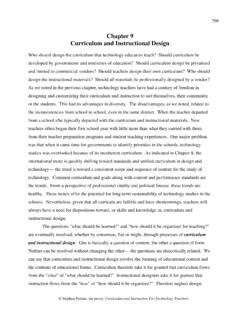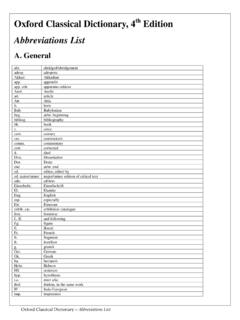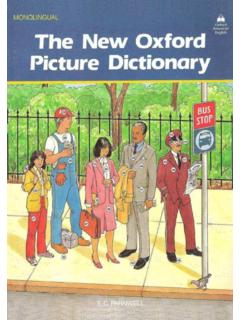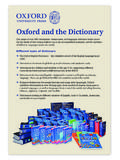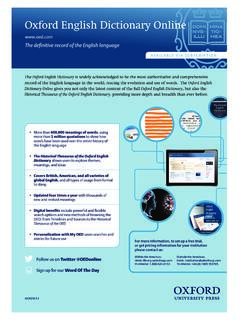Transcription of A Concise Anglo-Saxon Dictionary
1 A Concise anglo saxon DictionaryJohn R. Clark HallTable of ContentsA Concise anglo saxon R. Clark TO THE SECOND OF SIGNS AND ABBREVIATIONS WITH THEIR AND .. Concise anglo saxon DictionaryiA Concise anglo saxon Dictionary1 John R. Clark Hall This page formatted 2009 Blackmask Online. TO THE SECOND EDITION LIST OF SIGNS AND ABBREVIATIONS WITH THEIR EXPLANATION ADDITIONS AND CORRECTIONS A B C D E F G H I K L M N O P Q R S T U W Y Produced by Louise Hope, Zoran Stefanovic, the GermanicLexicon Project, and the Online Distributed ProofreadingTeam. [Transcriber's Note: This text is intended for users whose text readers cannot use the real (Unicode, UTF 8) version of thefile. Some compromises have been made, mainly in the spelling of Old English. Where possible, macrons ( long marks) are shown with circumflex accents: Long is split up as , while long y is approximated with.]
2 (The Dictionary rarely uses acute accents, and never for Old English.) The oe ligature (rare) is shown in brackets as [oe]. Greek words and letters (also rare) have been transliterated and are shown between +marks+.A Concise anglo saxon Dictionary2 The dagger and double dagger symbols have been replaced with and respectively; the + and symbols are as printed. Unless otherwise noted, words are spelled and alphabetized as in the original. The letter is alphabetized as ae . The letter (eth) is alphabetized separately after t . The letters j and v are not used; medial k occurs only once. When two words are otherwise identical, the one containing a macron is usually given second. Cross references are shown as printed. When there is an error or ambiguity, corrections are given in[[double brackets]] at the end of the entry or as a separate paragraph. Where possible, these standard wordingswere used: under m s The referenced word is either a secondary entry or a parenthesized alternative spelling in the form m s ( ).
3 Headword spelled m s Minor difference, generally an added or omitted macron or a predictable vowel variation such as for . form of m s The referenced word is an inflected form. A few very common patterns such as adverbs in l ce listed under adjectives in lic are not individually noted. redirected to m s The cross referenced form leads to further cross references. To avoid empty cross references, a few entries, clearly identified, were restored from the first edition. In the original book, shorter entries chiefly cross references were printed two or three to a line. Theyhave been separated for this e text. All [single brackets], asterisks* and question marks? are in the original. In the body of the Dictionary , italics are shown conventionally with lines, while small capitals are markedas text. Boldface in headwords is unmarked; elsewhere it is shown as text. Superscript numerals ( smallsuperior figures") are shown with a caret; braces are used when necessary to avoid ambiguity.
4 Wr on^1,2 strong verb, class 1 or 2 b rnett (y^2) second syllable also spelled with y 234^1 page 234, line 1 Typographical errors are listed at the end of the e text. To avoid confusion with original brackets,anything added by the transcriber is shown in [[double brackets]]. The New English Dictionary (NED) is now known as the oxford English Dictionary (OED).] * * * * * * * * * A Concise anglo saxon Dictionary CAMBRIDGE UNIVERSITY PRESS C. F. CLAY, Manager London: FETTER LANE, Edinburgh: 100 PRINCES STREET [Illustration: Publisher's Device] Bombay, Calcutta and Madras: MACMILLAN AND CO., Ltd. Toronto: J. M. DENT AND SONS, Ltd. Tokyo: THE MARUZEN KABUSHIKI KAISHAA Concise anglo saxon Dictionary3 All rights reserved A Concise anglo saxon Dictionary FOR THE USE OF STUDENTS by JOHN R. CLARK HALL, , Second Edition Revised And Enlarged New York: The Macmillan Company 1916 Cambridge: Printed by John Clay, at the University PressA Concise anglo saxon Dictionary4 PREFACE TO THE SECOND EDITION The first edition of this Dictionary having been exhausted, it has been extensively revised, and certain newfeatures and alterations have been introduced into it.
5 1. The principle of arranging all words according to their actual spelling has been to a considerable extentabandoned. It was admittedly an unscientific one, and opened the door to a good many errors andinconsistencies. The head form in this edition may be either a normalised form or one which actually occurs. 2. Words beginning with ge have been distributed among the letters of the alphabet which follow thatprefix, and the sign + has been employed instead of ge in order to make the break in alphabetical continuityas little apparent to the eye as possible. The sign has been used where a word occurs both with and withoutthe prefix. 3. References to Cook's translation of Sievers' anglo saxon Grammar, and to the GrammaticalIntroduction to Sweet's Reader have been taken out, as Wright's or Wyatt's Old English Grammar will havetaken their place with most English students. 4. A new feature which, it is hoped, will prove widely useful, is the introduction of references to all, ornearly all, the headings in the New English Dictionary under which quotations from anglo saxon texts are tobe found.
6 A vast mass of valuable information as to the etymology, meaning and occurrence of Old Englishwords is contained in that Dictionary , but is to a very large extent overlooked because it is to be found underthe head of words which are now obsolete, so that unless one happens to know what was the last form whichthey had in Middle English, one does not know how to get at it. This information will be made readilyavailable by the references in the present work, which will form a practically complete index to theAnglo saxon material in the larger Dictionary and will at the same time put the student on the track ofinteresting Middle English examples of the use of Old English words. Besides directing the reader (by meansof quotation marks) to the heading in the New English Dictionary where the relevant matter may be found, anindication has been given of the texts from which quotations are made therein, when these do not exceed fouror five[1].
7 [Footnote 1: As regards the letter W and some small parts of other letters which have not yet appeared in the NED, a reference has been given to its abridgement (The Concise oxford Dictionary ).] 5. There have been many valuable contributions to anglo saxon lexicography (by Napier, Swaen,Schl tter, F rster, W lfing and others) since the first edition of this Dictionary appeared, and these have beenmade use of, but (as before) unglossaried matter has not been systematically searched for words not hithertorecorded in anglo saxon Dictionaries[2]. [Footnote 2: The part of the Supplement to 'Bosworth Toller' which has already appeared shows that Professor Toller is examining such matter with great care and thoroughness.] 6. The number of references to passages has been very largely increased. All words occurring only inpoetical texts have been marked. If they occur more than once they bear the sign , if only once, a reference tothe passage is generally given.
8 If not they are marked . As regards prose texts, the rule has been only to givereferences to particular passages in the case of rare words, more especially +hapax legomena+. Thereferences to AO, CP and which were given in the earlier edition have been retained, as a useful indicationthat the word occurs in Early West saxon or Late West saxon prose, as the case may be. 7. By various devices it has been found possible, while much increasing the amount of matter in the book,to add very slightly to the number of pages, and at the same time to reduce the number of columns on a pagefrom three to two. Most of these devices are more or less mechanical, but one method of saving space may bementioned. Certain compound words, descriptive of places, which, as far as I know, occur only in charters andA Concise anglo saxon Dictionary5which may often be more correctly regarded as proper nouns, have not been separately inserted. Theirmeaning can however always be ascertained by referring to their components, and where the abbreviation Mdfis inserted the reader will understand that examples of words so compounded, or of the components, or ofboth, will be found in Birch's Cartularium Saxonicum, or in Earle's Land Charters, and that references tothose examples are given in Middendorff's Altenglisches Flurnamenbuch.
9 8. In the List of Abbreviations, etc. at the commencement of the book, editions of texts which arefurnished with a glossary have been specially indicated. J. R. C. , Concise anglo saxon Dictionary6 LIST OF SIGNS AND ABBREVIATIONS WITH THEIR EXPLANATION Note 1. Where references are in italic type, quotations from the texts indicated will be found in the NewEnglish Dictionary , under the head of the English word which is distinguished in the article by quotationmarks (see Preface). In references to special passages volumes have been marked off from pages by aninverted full stop, and lines or verses have been shown, where they follow other numerals, by small superiorfigures. Occasionally where lines have not been given, the mark has been inserted to show that the quotationis in the lower half of a page. Note 2. In the following list the number (1) after an edition of a text indicates that the edition is suppliedwith a complete referenced glossary or word index, (2) that it has a complete glossary, but without referencesand (3) that it has a partial glossary or word index.
10 Note 3. Some of the abbreviations given below are used in combination. Examples: MtLR theLindisfarne and Rushworth MSS of St Matthew; BJPs the Bosworth and the Junius Psalters; singular feminine. EK Early Kentish. ' ' Quotation marks are used to enclose the English words which should be looked up in the NED in order to find etymological information as to, and examples of the use of, the anglo saxon words to which the articles in this Dictionary relate, see Note 1 above. If they enclose Latin words, they indicate the lemmata of anglo saxon words in glosses or glossaries etc., or the Latin equivalent of such words in the Latin texts from which they are translated. The Latin is especially so given when the Ags. word seems to be merely a blindly mechanical and literal equivalent. * is prefixed or affixed to hypothetical forms. Normalised forms of Ags. words which actually exist are not usually so marked.

